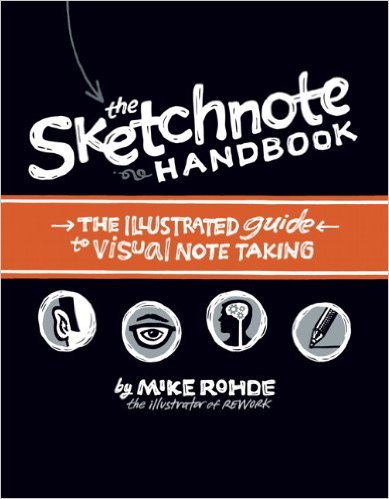Write/Speak/Code is the first conference I tried sketchnoting, and people loved it. I was really surprised because I still consider myself someone who cannot draw, but somehow I am good at sketchnoting. How come?
Constraint satisfaction problem
Naturally, I will explain my approach with a sketchnote:
When I took Alexis' sketchnotes class three years ago, I was really hung up on the idea that I needed to draw. The repertoire of shapes and objects that I can draw is really small, so I never actually tried sketchnoting after the class.
What changed? I flipped the problem around. I phrased it as a constraint satisfaction problem. I am using a small toolbox to express ideas I heard. And as an engineer, I am extremely good at that.
In the sketchnote above, I wanted to convey the idea that illustrations do not need to be realistic. At first I wanted to draw two trees, one realistic, one not. But alas, I cannot draw a realistic tree. Instead of giving up, I worked around by drawing a box with a dotted line to represent the realistic tree that I am unable to draw. Problem solved.
I am not kidding when I say my toolbox is small. You can see it in the sketchnote. The plain old notes vs sketchnotes part. That is literally my toolbox.
Use a pen
The other breakthrough came when I saw The Sketchnote Handbook by Mike Rohde in my local library:

The most important thing I picked up from the book is to use pen instead of pencil. This forces me to always make progress instead of erasing and re-drawing and second-guessing myself. It also makes me more forgiving of my mistakes, and come up with creative ways to fix them.
In the toolbox about bullet lists, I made two bullets with stars, because a single bullet doesn't make a list. And then I realized that I have nothing to more to say. What to do? The second star was already drawn. With ink.
I ended up writing "There is no second point" next to the second star. And you know what? It now emphasizes the fact that it doesn't take much to make sketchnotes.
A lot of serendipity came from using a pen and being forced to make things work.
Find your style
I really enjoyed the The Sketchnote Handbook because it includes examples from many sketchnoters. I pick and choose techniques that works for me:
- Some sketchnotes are very free form, popping images left and right seemingly randomly. That terrifies me. But many examples use a grid style. I came up with my own layout algorithm: top to bottom, and if an item took too little horizontal space, put something next to it. This is very similar to traditional note taking, just using a bit more horizontal space. I can do that.
- Some sketchnotes fill the whole page, and the pressure to do so paralyzes me. But many examples have whitespace between the items, and that is totally okay.
- The book recommended using a vertical layout for panels, drawing the face of one panelist on each column. There is no way I can draw portraits. So I skipped that part. But it also showed a few simple ways to draw people. Now Starfish Man is a regular cast member in my sketchnotes.
Share
This is the most potent motivator: Twitter. You know how some people take a screenshot of a block of text to get around the 140 character limit? That looks stupid. But I can totally post a sketchnote to stuff more content into a tweet. And it looks awesome. So awesome that I get lots and lots of retweets, which gave me the confidence to do more sketchnotes, which gets more retweets.
Dealing w/ "I cannot draw" by sketchnoting: You Are Not Your Impostor Syndrome by @nerdneha at #wsc2015conf pic.twitter.com/HTXm5wpYuk
— Chiu-Ki Chan (@chiuki) March 19, 2015From Conference Organizers Panel: What do you look for in a conference proposal? #wsc2015conf pic.twitter.com/ki0VhAXvH0
— Chiu-Ki Chan (@chiuki) March 20, 2015Speaking Effectively by Melissa Collom #wsc2015conf pic.twitter.com/5bxa6Weh9M
— Chiu-Ki Chan (@chiuki) March 20, 2015Owning it: The art of being awesome by @antiheroine at #wsc2015conf pic.twitter.com/46Pea7l82l
— Chiu-Ki Chan (@chiuki) March 21, 2015Gotta love that positive feedback loop!

Inline coding questions will not be answsered. Instead, ask on StackOverflow and put the link in the comment.
Cool.
ReplyDeleteI find that writing on paper (with pen) is much better for me than trying to type notes into a computer or phone. However, my notes are the "first pass" before I have a chance to digest everything. Once I have thought about it (often in the evening, reviewing the notes I made during the day), the notes are no longer the right thing for me, so I write them again (on the computer), with further thoughts, notes, links, etc.
GEESE IN TUXEDOS is fun but it's usually not the thing I want to remember most prominently when I organize my thoughts. :)
As an engineer have you ever used Sketchnotes in your work? I am struggling to take effective meeting notes and I'm looking for a better way but I'm not sure how I would use this at work. All the examples I have seen are from conferences or people who are not working in technical fields. Thoughts?
ReplyDeleteI haven't, mostly because I work from home and manage to avoid most meetings :)
DeleteMy friend and fellow Android engineer Corey Latislaw takes meeting notes this way though, so perhaps you can ask her: https://twitter.com/corey_latislaw/
Thank you Chiuki, because of you I discovered this awesome way to take notes :D
ReplyDelete